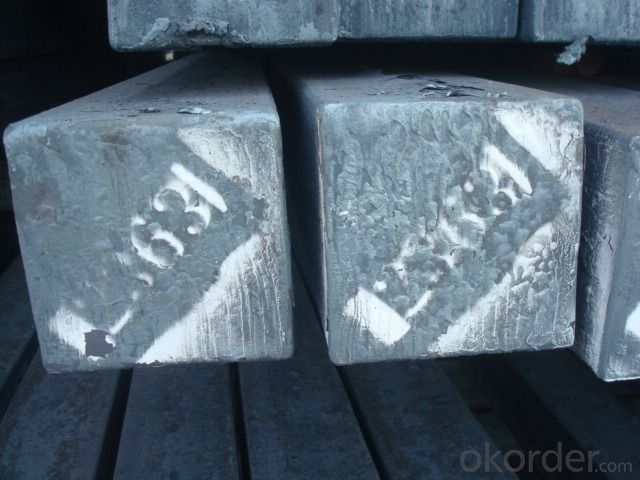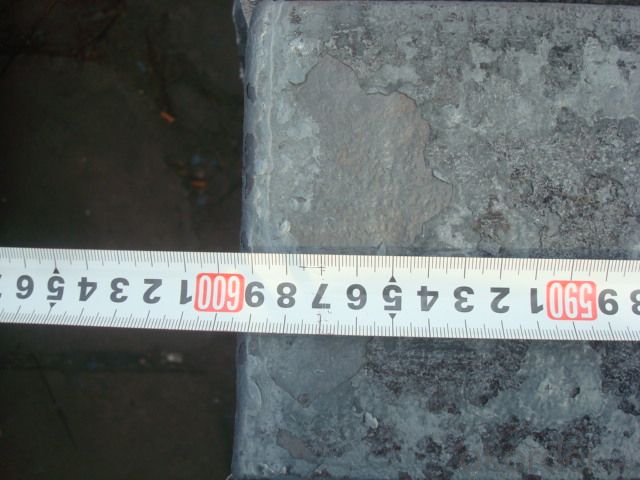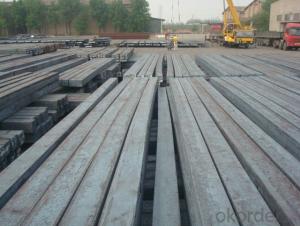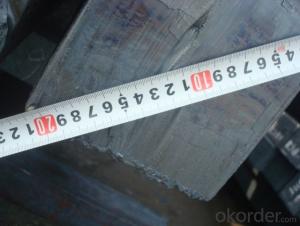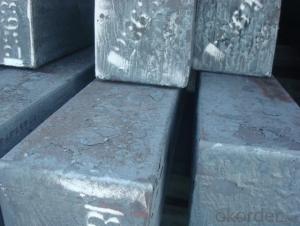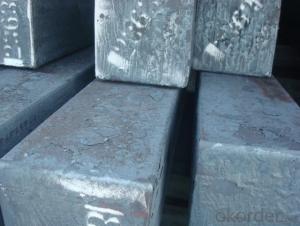Continue Casting Steel Billet Made by Blasting Furnace
- Loading Port:
- Tianjin
- Payment Terms:
- TT OR LC
- Min Order Qty:
- 1000 m.t.
- Supply Capability:
- 100000 m.t./month
OKorder Service Pledge
OKorder Financial Service
You Might Also Like
Continue Casting Steel Billet Made by Blasting Furnace
1.Structure of Continue Casting Steel Billet Made by Blasting Furnace
Continue Casting Steel Bloom Manufactured by Blasting Furnace is the raw material of all kinds of steel mill. Billet section of square, round, flat, rectangular and abnormity, etc Several, mainly related to shape of rolled products. Simple rolled section steel, choose cross section of square billet or rectangular billet. rolling The sector products such as flat steel, Angle steel, select the rectangular billet or slab. Had better profiled billet when production beams, channels, and in rolling process Lines and improve the yield. The raw material of round billet is the production of seamless tube.
2.Main Features of Continue Casting Steel Billet Made by Blasting Furnace
Continue Casting Steel Bloom Manufactured by Blasting Furnace section size should meet the requirements of rolling deformation and finished product quality, but also roll strength and biting condition of restrictions. General steel Billet section height H. And the roll diameter D The ratio of the ( namely H/D) Should be less than or equal to zero 0.5 . Length of steel billet by finishing temperature, Rolling time and the length of the product Or times ruler. When heated too long accident prone to bump the furnace wall of steel, too short, furnace bottom utilization rate is not high, influence the heating furnace production. For the production Choose a variety of steel and steel billet, should consider the affinities of billet, as far as possible in order to improve the productivity of the roughing mill, simplify the stock management of workshop.
3. Continue Casting Steel Billet Made by Blasting Furnace Images


4. Continue Casting Steel Billet Made by Blasting Furnace Specification
1)SIZE
2)MATERIAL GRADE
3)CHEMICAL ELEMENTS COMPOSITONS
Material standard The editor Range of thickness: 150-240 - mm + / - 5 mm width range: 880-1530 - mm + / - 20 mm Length: 3700-10000 - mm + / - 500 - mm Cross-sectional size: 64 * 64; 82 * 82; 98 * 98; 124 * 124; 120 * 150; 152 * 164; 152 * 170 mm Length: 9000 mm Section of tolerance: billet: 1.0 + / - 2.0-1.0 + / - 1.0 mm slab: width: + / - 2.0 mm thickness: + / - 3.0 mm The length tolerance: + / - 200 mm Section diagonal tolerance: 3.5-8.0 MM Billet section size protrusions requirements: < 1242 mm, do not allow; > = 1242 mm, < = 2 mm 1242 mm, < = 3 mm Beheading (shear) extension deformation: < 1242 mm billet: no control; The slab: < = 15 mm Surface tilt: no more than billet section 0.1 Bending: every 1 m length is not more than 10 mm The distortion: length < = 5 m, < = 11. ; The length of the < = 7.5 M, < = 5. Material % 3 sp/PS chemical composition: C Mn Si S P
The classification of the steel According to the quality classification (1)Ordinary steel (P 0.045% or less,S 0.050% or less)POn behalf ofphosphorus,s.On behalf ofsulfur Pands.Are all of the steelThe harmful elements, a leading toHot brittleness, a leading toCold brittle (2)High quality steel (P,s.both0.035% or less) (3)High quality steel (P 0.035% or less,S 0.030% or less
5.FAQ of Continue Casting Steel Billet Made by Blasting Furnace
We have organized several common questions for our clients,may help you sincerely:
①How to make diffirence of the grades?
You can do the chemical composition of the products by some lab.for example send the samples to SGS inspeciting company.
②If we want to get the shortest production term, which spec. is more easy to produce?
150*150*12000MM, Q235.
③Which steel mill is the best quality?
In China, if the national steel mill's quality is very good and stable, or private steel mill, you have to make sure the furnace is blast furnace and the quantity every day is big enough.
- Q: What are the different quality control measures for steel billets?
- There are several quality control measures for steel billets, including visual inspection, dimensional checks, chemical composition analysis, mechanical testing, surface inspection, and ultrasonic testing. These measures help ensure that the steel billets meet the required specifications and standards, ensuring their suitability for further processing and use in various industries.
- Q: What are the potential applications of steel billets in the chemical aftermarket?
- The chemical aftermarket offers a multitude of possibilities for the utilization of steel billets. One significant application of these billets lies in their role in the production of various chemical processing equipment. Reactors, heat exchangers, columns, and other critical components utilized in chemical plants can all be manufactured using steel billets. Furthermore, steel billets are also employed in the construction of storage tanks designed for the safe containment of chemicals. These tanks must possess qualities such as strength, durability, and resistance to corrosion, which can be achieved through the use of steel billets. Moreover, steel billets find their purpose in the fabrication of pipelines and piping systems used for the transportation of chemicals. Their exceptional strength, as well as their ability to withstand extreme temperatures and pressures, make them an ideal choice for constructing pipelines capable of handling corrosive and hazardous chemicals. Additionally, steel billets can be shaped and formed into various fittings and flanges, which serve as essential components in chemical systems. These fittings and flanges play a vital role in connecting different sections of piping, valves, and other equipment, thereby ensuring a secure and leak-free operation. To summarize, the potential applications of steel billets in the chemical aftermarket are vast and varied. From the manufacturing of chemical processing equipment to the construction of storage tanks, pipelines, and fittings, steel billets play a crucial role in guaranteeing the safe and efficient operation of chemical facilities.
- Q: How do steel billets contribute to the overall durability of a product?
- Steel billets play a crucial role in elevating the overall durability of various products, and their contribution cannot be overstated. These semi-finished steel products serve as raw material for further processing in industries such as construction, automotive, and manufacturing. A key factor in the enhanced durability provided by steel billets is their superior strength and toughness. Steel is renowned for its exceptional mechanical properties, including high tensile strength and resistance to deformation, making it an optimal choice for applications that require durability. By utilizing steel billets as the initial material, manufacturers can guarantee that the final product will possess the necessary strength to endure heavy loads, impacts, and external forces. Additionally, steel billets exhibit outstanding corrosion resistance. With proper processing and treatment, steel can withstand rust and other forms of corrosion caused by moisture, chemicals, or environmental factors. This corrosion resistance significantly enhances the durability of the end product by preventing degradation and extending its lifespan. Another advantage of employing steel billets lies in their versatility for customization. Manufacturers can shape and form the billets into various sizes and dimensions to meet the specific requirements of the product. This flexibility enables the production of components that fit together perfectly, reducing the risk of weak points or vulnerabilities in the overall structure. Furthermore, steel's malleability and ductility allow for easy molding and welding, further enhancing the overall strength and durability of the final product. Furthermore, steel billets undergo stringent quality control measures during the manufacturing process. These measures ensure that the billets meet rigorous industry standards and specifications, guaranteeing their reliability and consistency. The utilization of high-quality steel billets, in turn, contributes to the overall durability of the product by providing a sturdy and dependable foundation. In conclusion, steel billets play a pivotal role in enhancing the overall durability of products. Their exceptional strength, corrosion resistance, versatility, and high-quality attributes make them an optimal choice for industries that prioritize durability. By utilizing steel billets as the raw material, manufacturers can create products capable of withstanding demanding conditions, ensuring longevity and customer satisfaction.
- Q: Can steel billets be recycled?
- Yes, steel billets can be recycled. Steel is a highly recyclable material, and the recycling process for steel billets is relatively straightforward. When steel billets, which are typically produced through a casting process, are no longer needed or have reached the end of their lifecycle, they can be recycled and transformed into new steel products. The recycling process begins with the collection and sorting of the steel billets. They are then transported to a recycling facility where they are melted down in a furnace. Once melted, impurities are removed, and the resulting molten steel is formed into new billets or other steel products through various shaping and casting techniques. Recycling steel billets not only helps to conserve natural resources and reduce waste but also has significant environmental benefits. The recycling process requires less energy and emits fewer greenhouse gases compared to the production of steel from raw materials. Additionally, recycling steel helps to reduce the demand for mining iron ore, which can have detrimental effects on the environment. Overall, steel billets can be effectively recycled, allowing for the sustainable and responsible use of this versatile material.
- Q: How are steel billets used in the production of gears?
- Gears are manufactured using steel billets as the raw material. These billets are semi-finished steel products with a square or rectangular cross-section. They are heated and hot-rolled to shape them into gears. The first step in gear production with steel billets is selecting the appropriate steel grade. This grade should have specific mechanical properties, such as high strength, toughness, and wear resistance. These properties ensure that the gears can withstand the demanding conditions they will face during operation. Once the steel billets are chosen, they are heated to a high temperature to make them malleable and easier to shape. This heating process, known as hot working, allows the steel to be deformed without cracking or fracturing. The billets are then passed through rollers to shape them into gears with the desired dimensions. After the initial shaping, the gears may undergo additional machining operations to refine their shape and improve precision. These operations, like milling, grinding, or hobbing, remove excess material and create the final gear profile. By doing so, they ensure that the gears meet the required tolerances and have smooth surfaces for optimal performance. Once the gears are machined to the desired specifications, they may undergo heat treatment processes like quenching and tempering. These processes enhance the gears' mechanical properties by increasing their hardness and strength. This makes the gears more durable and resistant to wear. Overall, steel billets are essential in gear production as they serve as the starting material for the manufacturing process. Through heating, shaping, machining, and heat treatment, steel billets are transformed into high-quality gears that are strong, durable, and precisely engineered to meet the specific requirements of different mechanical applications.
- Q: How are steel billets used in the manufacturing of chemical processing equipment?
- Steel billets are used in the manufacturing of chemical processing equipment as raw material for forging or casting various components such as valves, pumps, heat exchangers, and reactors. These billets are shaped, machined, and treated to meet the specific requirements of the equipment, ensuring strength, durability, and resistance to corrosion and high temperatures.
- Q: What are the common grades of steel used for billets?
- The common grades of steel used for billets include mild steel, carbon steel, and alloy steel.
- Q: How do steel billets contribute to the manufacturing of medical equipment?
- The manufacturing of medical equipment is greatly aided by steel billets. Various components of medical equipment are produced using steel billets as the raw material. These billets are melted and then formed into tubes, rods, or sheets, which are subsequently utilized to create essential parts of medical equipment. For example, scalpels, forceps, and scissors, which require precision and durability, are commonly manufactured using steel billets. Steel's strength and resistance to corrosion make it the ideal material for these instruments. By melting and shaping steel billets into specific forms, the reliability and longevity of these instruments are ensured. Furthermore, medical implants such as hip replacements, knee replacements, and dental implants require materials that are biocompatible, strong, and resistant to wear. Steel billets, especially stainless steel, fulfill these requirements and are employed in the creation of implants that enhance the quality of life for many patients. In addition, steel billets contribute to the manufacturing of medical equipment by providing the framework for devices like hospital beds, surgical tables, and examination tables. These structures need to be sturdy, stable, and capable of supporting the weight of patients. Steel billets are transformed into various shapes and sizes to construct the frames and bases of these equipment, ensuring their robustness and reliability. To summarize, steel billets play a vital role in the manufacturing of medical equipment. They serve as the raw material, which is melted, shaped, and converted into components, instruments, and structures necessary for the production of surgical instruments, implants, and medical devices. The strength, durability, and corrosion resistance of steel make it an ideal material for manufacturing medical equipment that meets the stringent standards of the healthcare industry.
- Q: How are steel billets used in the production of beams and columns?
- Steel billets are used as a raw material in the production of beams and columns. They are heated and then passed through a series of rolling mills to be shaped into the desired beam or column profiles. The billets provide the necessary strength and durability required for structural applications, ensuring the final products can withstand heavy loads and provide support in construction projects.
- Q: How do steel billets contribute to the overall safety of a product?
- Steel billets contribute to the overall safety of a product by providing a strong and durable foundation. They are used as raw material in the manufacturing of various products, including construction materials, automotive parts, and machinery. The high strength and structural integrity of steel billets ensure that the end products are able to withstand heavy loads, extreme conditions, and potential hazards, thus enhancing safety and reliability.
Send your message to us
Continue Casting Steel Billet Made by Blasting Furnace
- Loading Port:
- Tianjin
- Payment Terms:
- TT OR LC
- Min Order Qty:
- 1000 m.t.
- Supply Capability:
- 100000 m.t./month
OKorder Service Pledge
OKorder Financial Service
Similar products
Hot products
Hot Searches
Related keywords


